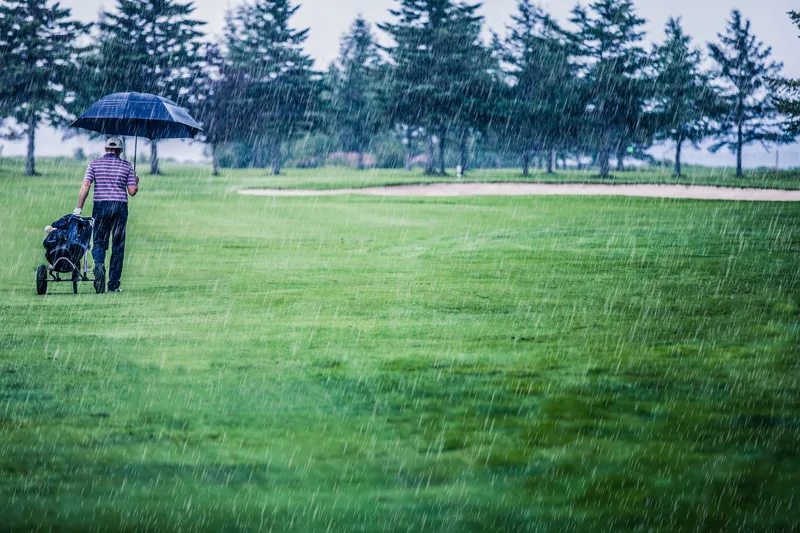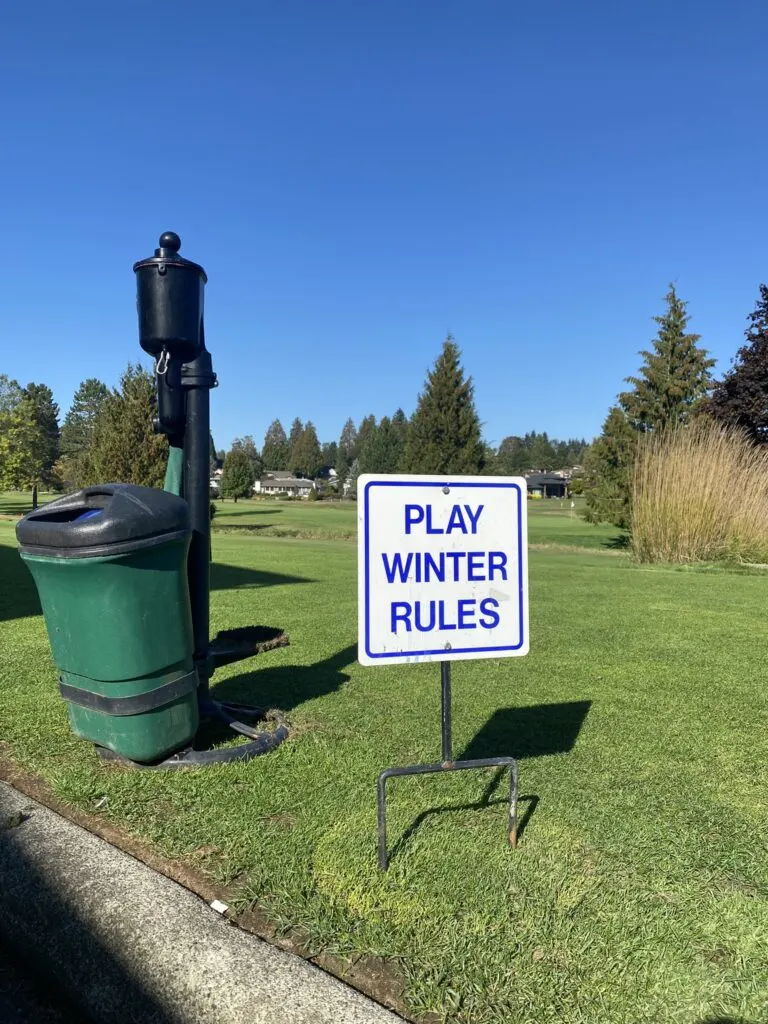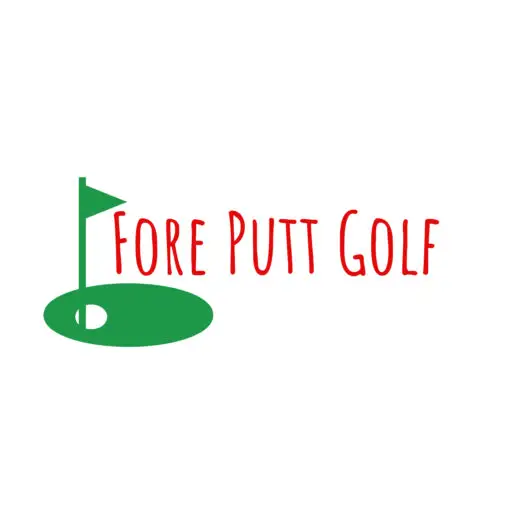Winter rules, also known as preferred lies, are USGA-sanctioned rules instituted at the local level when course conditions warrant it.
Winter rules allow you to lift, clean, and place your ball in certain areas of the course.
Typically, it is used when the golf ball is likely to get muddy, like when it is rainy and wet.
Mud, dirt, and water can significantly affect the flight of a golf ball.
Winter rules are typically used from late fall to early spring.
Many courses in the northern United States, the Pacific Northwest, utilize winter rules from sometime in November to sometime in March.
If it is wet, rainy, and cart path only is in effect, you will likely be playing winter rules.
USGA Winter Rules
The USGA has only recently (2015) included winter rules in the official Rules of Golf.
It’s an allowance that the USGA has decided to allow at the local level to enhance the enjoyment of the game for the masses. It is meant to be only used under adverse conditions and when truly warranted.
Under Rule E-3 Preferred Lies, the USGA advises that “Such a Local Rules should be withdrawn as soon as conditions allow.”
USGA Model Local Rules E-2 and E-3
First, the USGA has two model local rules pertaining to winter rules: Model Local Rule E-2 and Model Local Rule E-3.
In short, E-2 allows for the lifting and cleaning of your ball, and E-3 provides for the placing of your ball.
Local Rule E-2
E-2 specifically allows for the lifting, cleaning, and replacing of a ball in an area cut to fairway height or less. This means you can lift and clean your ball, but you must put it back exactly where you lifted it.
Local Rule E-3
E-3 allows for free relief.
Under local rule E-3, you may take free relief once (meaning you get one placement, you can’t keep moving your ball around until you find a spot you like best) by placing your ball within a specified relief area no nearer to the hole.
The specified area is determined by your course or tournament committee and can vary depending on course conditions.
Typical relief area measurements are six inches or one club length.
This rule, along with rule E-2, are the basis for “winter rules” which allows you to lift, clean, and place your ball.
The USGA strongly recommends that these rules only be allowed in areas cut to fairway length or less:
“The use of this Local Rule outside the fairway in the general area is not recommended as it may result in a player receiving free relief from areas where a ball might otherwise be unplayable.”
https://www.usga.org/content/usga/home-page/rules/rules-2019/committee-procedures/rule-8.html#:~:text=E%2D2%20Cleaning%20Ball&text=While%20the%20Local%20Rule%20for,or%20restricted%20to%20specific%20areas.
How To Properly Adhere to “Winter Rules”

Ever wonder why your buddy who rarely breaks 90 all summer is suddenly shooting 83 when the weather changes and winter rules are instituted?
Two reasons:
- Soft greens make it much easier, particularly for bad players.
- He doesn’t know what winter rules actually means.
Although many people take winter rules to mean that they can lift, clean, and place all their shots, that is not the case.
When You CAN’T Use Winter Rules
When your ball is anywhere other than in the fairway.
Preferred lies should not be used in the rough.
It is considered too advantageous to be allowed to clean and essentially tee up a poor shot.
Allowing lift, clean, and place in the rough gives an unfair advantage to those that are unable to find the fairway.
Other places it doesn’t apply:
- In the sand
- Under a tree
- In a bush
- Pretty much anywhere other than short grass
When You CAN Use Winter Rules
When your ball is in an area cut to fairway height or less.
Winter rules are meant to give you the same lie you would have had if the course conditions weren’t so poor: a good lie with a clean, dry golf ball on the fairway.
It is not meant to allow those that can’t find the fairway to “tee up” every wayward shot from the rough.
This is something that most recreational golfers do not know; they lift, clean, and place everything.
And very rarely within the advised 6 inches to one club length no nearer to the hole.
Embedded Balls
An embedded ball is one that
“is in its own pitch-mark made as a result of the player’s previous stroke, and part of the ball is below the level of the ground.”
https://www.usga.org/content/usga/home-page/rules/rules-2019/rules-of-golf/rule-16.html
According to Rule 16.3, you are allowed free relief from an embedded ball anywhere except in the sand, and the relief area is one club length no nearer to the hole.
Interestingly, a committee can adopt Model Local Rule F-2 if they so choose, which would not allow for free relief from an embedded ball in an area not cut to fairway height or less.
Who Decides When To Allow Winter Rules?
The tournament committee or the course superintendent are the ones that decide when to allow winter rules and what exactly those rules for that day are.
It is not up to you to decide that it should be winter rules because the ground is a little wet.

Although if you’re just playing with some buddies and you all agree to a specific set of winter rules, go ahead and play; just don’t post your scores.
Most courses aren’t very good at explaining what winter rules actually means.
They just stick a sign in the ground on the first tee box that says “Play Winter Rules,” and members go and essentially do whatever they think winter rules means.
Some lift, clean, and place everything, no matter where it is.
Some place it a club length or more from where it landed.
Some even use it in the bunker to move their ball out of a penalty area.
Some take it even a step further and play preferred lies year-round whenever they can get away with it!
Active vs. Inactive Handicap Season
The USGA specifies an active and inactive handicap season for some regions of the country due to course conditions and the fact that many courses use winter rules during these periods.
In fact, only 16 states have a year-round active season.
For example, the active handicap season in Washington State is March 1 – November 14th.
In other words, about the time winter rules is in full effect in Washington State, the USGA says none of your scores count for your handicap.
Why?
Because winter rules can make the game significantly easier, particularly if preferred lies are allowed in the rough.
This can artificially lower handicaps and hurt the handicapping system.
Course Specific Interpretations
Some courses take it upon themselves to adapt the rules to serve their members best based on course conditions.
Because the USGA doesn’t allow handicaps to be submitted in many states for 4-5 months per year, many courses in those states modify “winter rules” to enhance the enjoyment of the game for their members or customers.
For example, the “winter rules” for my course in the Pacific Northwest is that you can lift, clean, and place anywhere on the course. The relief area is 6” in the rough and one club length in the fairway.
Properly Using Preferred Lies
Unless you are specifically told otherwise, you should always assume winter rules (preferred lies) means the following:
- Lift, clean, and place is allowed only on areas of the course that are cut to fairway length or less or areas of the course that are specifically marked.
- The relief area is likely between 6” and one club length and should be clearly stated before starting your round.
Lastly, adhering to winter rules is up to you.
If it’s a tournament, you should take every advantage you can and play winter rules if allowed.
If you are just playing for practice and working on your game, I recommend you play it as it lies as much as possible.
If it’s covered in mud, go ahead and clean it, but you don’t need to lift, clean, and place every ball, every time.
Related:


